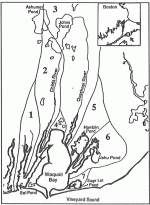Coupling of Watersheds and Coastal Waters
LMER RESEARCHERS are taking a whole-ecosystem approach to the study of Waquoit Bay on Cape Cod, Massachusetts, to assess how increased deforestation and urbanization may lead to greater nutrient loading from watersheds to adjoining coastal waters. This shallow bay (maximum depth 2.7 meters) is protected by barrier beaches. As in many similar lagoons or bays, groundwater is the major source of freshwater-borne nutrients.
About 12%, or 630 hectares, of the Waquoit Bay hydrologic system is covered by estuarine waters. Together the seven sub-watersheds total 4,619 hectares; the total area of land and water in the watershed is 5,366 hectares.
Waquoit Bay was designated a National Oceanic and Atmospheric Administration (NOAA) National Estuarine Research Reserve (NERR) in 1987 because of its location, regional importance, and potential for research. The NERR management plan fosters both conservation and research activities, and coordinates with state initiatives to purchase land and implement regulations to protect the Bay and selected subwatersheds. NOAA-NERR research on Waquoit Bay has provided the background data for the LMER studies.
Coupling Terrestrial and Marine Components
The structure of the Waquoit Bay-LMER studies is based on the identification of sub-watersheds that have undergone different degrees of development, as well as adjoining sub- estuaries that receive nutrient loadings from these sub-watersheds. A series of hypotheses about the nutrient dynamics in terrestrial and marine parts of the coastal landscape are being tested, as well as the effects of inputs from watersheds and tidal flushing on key biotic components of the marine ecosystem.
The terrestrial components of the program involve measuring and modeling
- Inputs of nutrients into each of the sub-watersheds
- Nutrient storage and transformations within both the sub-watersheds and aquifers
- Transport and attenuation of nutrients in groundwater and streams. Coupling of the marine components to the sub-watersheds involves measuring and modeling
- The release and transformation of nutrients as they pass from the watershed across the sediment- water interface and into coastal ecosystems
- The effects of hydrographical features on nutrient supply and turnover rates
- The influence of nutrient supply on the productivity of macroalgae, eelgrass, phytoplankton and benthic algae
Inputs to the ecological model are designed to operate at decade, monthly and tidal time scales. These various models will be used to examine hypotheses, structure measurements to verify the models, synthesize various data, and describe how coupled watersheds and coastal waters operate.
Approach and Methodology
Mass balance measurements are being taken of nutrient fluxes onto watersheds, transformations by vegetation and soil, transport into and within groundwater, and flux through subtidal sediments into overlying water. The effects of these fluxes of nutrients on oxygen content of water, on nutrient transformations, transport, and release in the sub-estuaries, and on the primary producers (macroalgae, phytoplankton, seagrasses) are being studied, as well as the role of tidal flow, bathymetry, and stratification in transport, supply, and loss of nutrients. A variety of research techniques is being employed, including Geographical Information Systems (GIS) and natural stable isotopes, along with more traditional field and laboratory measurements. The research program includes ecological, hydrological and hydrographical models, manipulative experiments, and field measurements to investigate how changes in the land use and vegetation mosaic of coastal watersheds are coupled to changes in nutrient dynamics and primary production in shallow coastal ecosystems. Because the inputs to these models are the pervasive changes altering coastal zones, it is expected that the models --and the related research results-- will provide good tools for examining applied aspects of nutrient loading and water quality.
Preliminary Results:
Work done in similar bays, and current work in Waquoit Bay, shows that there are strong seasonal fluctuations in

 Enlarge this image
Enlarge this image